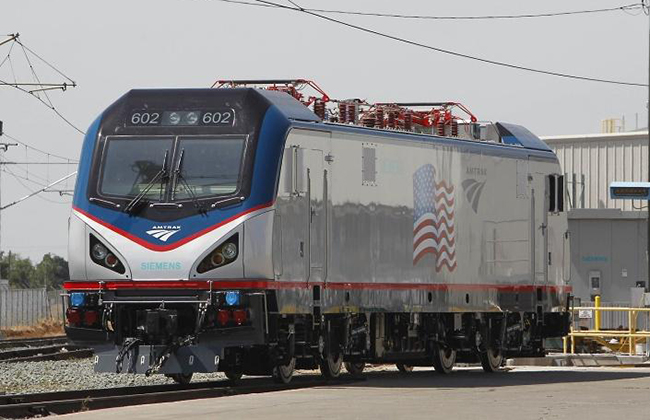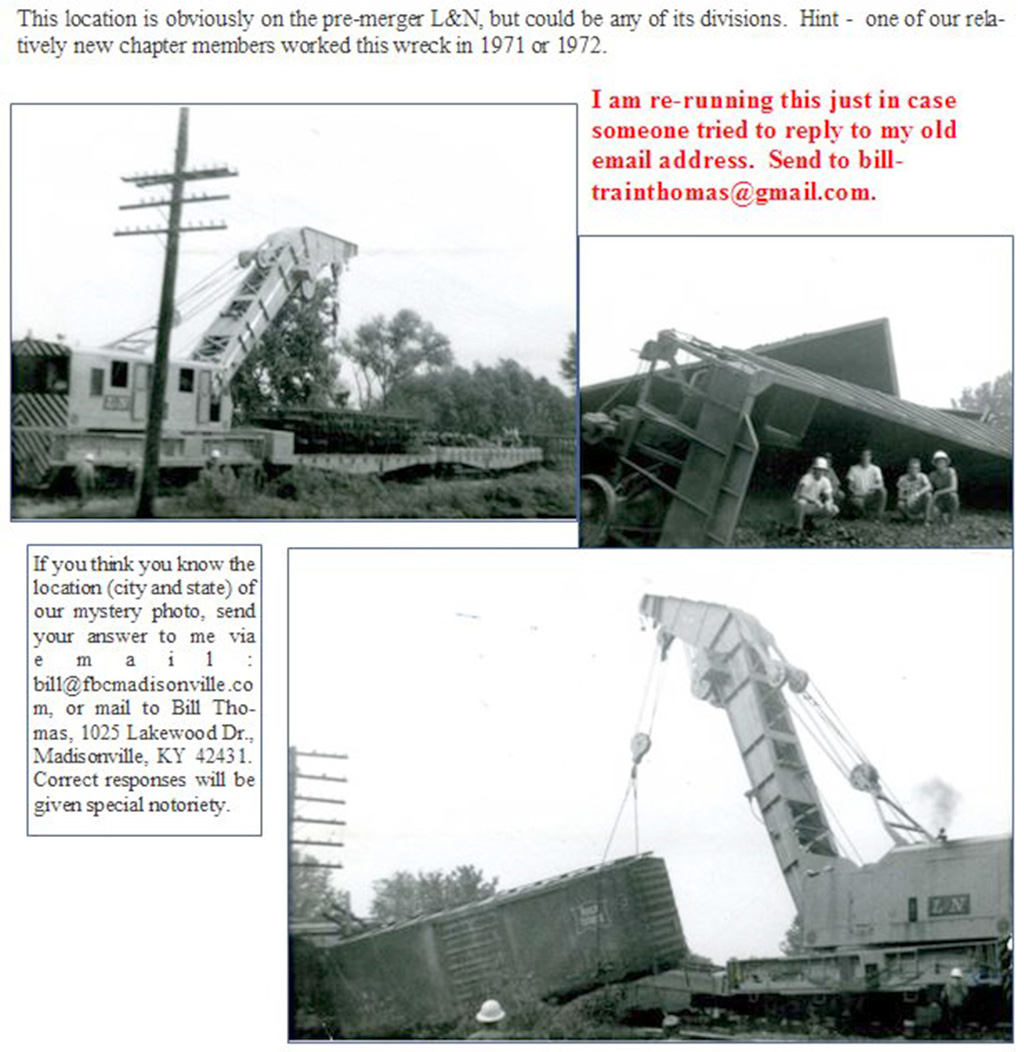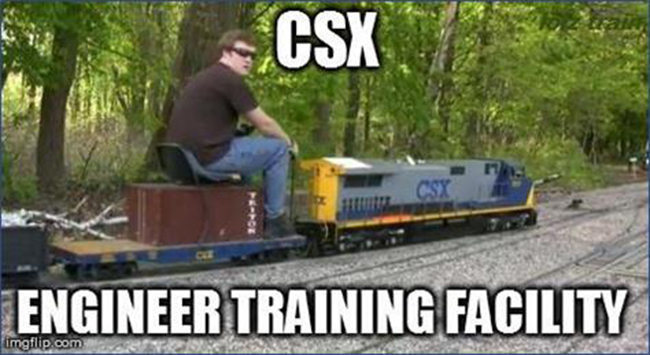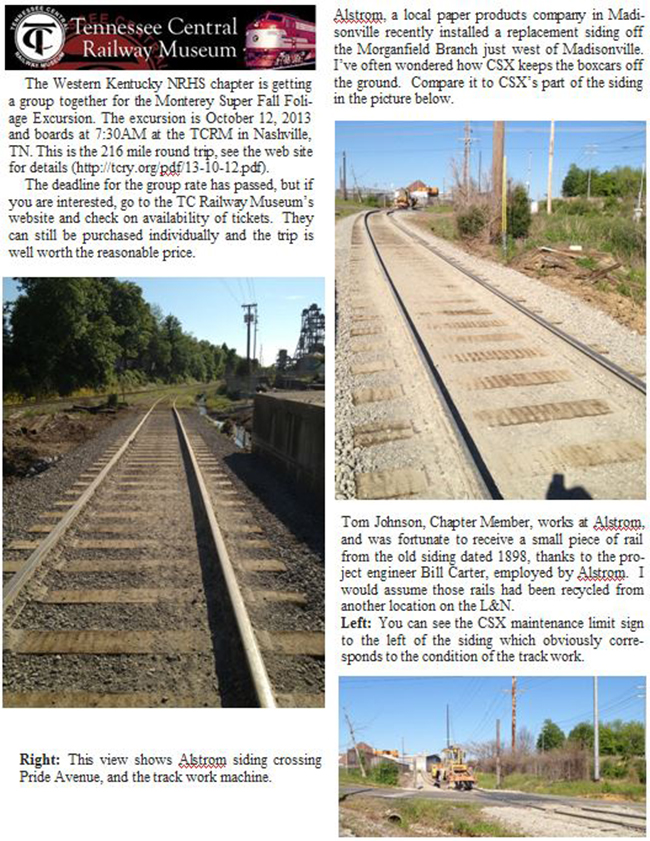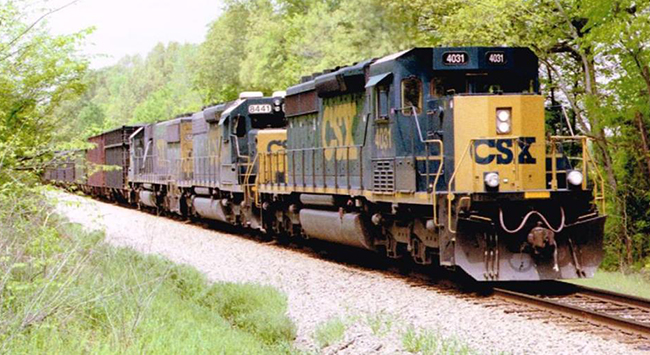Year: 2013
 by Rick Bivins, Chapter President
by Rick Bivins, Chapter President
Hello again Chapter Members and welcome to June, 2013. As some of you will recall, May found us in Hopkinsville KY. as guests of our Hopkinsville Members. Our meeting was held in the former Louisville & Nashville Passenger Station which is a wonderful venue. The weather was perfect, many members were on hand and CSX provided us with a few trains, one being an ICE (Iowa, Chicago & Eastern) run-through no less! And of course we had food! Boy did we have food. Mr. Ferrell and his staff went all out with burgers, dogs and all the trimmings. WHEW!
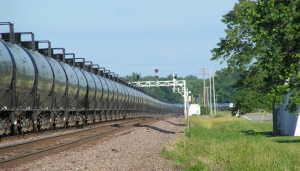 Change came about the meeting unexpectedly but with a positive outcome. The program was to be presented by Cliff Downey. The subject was to be Illinois Central’s KY Division. However, Cliff was called into work at the last minute to make repair of a hospital machine that was evidently needed right away. We certainly do not fault him for that. Cliff expressed his grief but he has been assured a program slot of his choosing in the near future. In place of our usual program time we simply enjoyed good food, camaraderie and relaxed. We did take time out to have a business meeting. Discussion was had on the upcoming Chapter Train Ride in Tennessee along the former Tennessee Central, Friday Night Live, the scuttled Progress Rail trip and………
Change came about the meeting unexpectedly but with a positive outcome. The program was to be presented by Cliff Downey. The subject was to be Illinois Central’s KY Division. However, Cliff was called into work at the last minute to make repair of a hospital machine that was evidently needed right away. We certainly do not fault him for that. Cliff expressed his grief but he has been assured a program slot of his choosing in the near future. In place of our usual program time we simply enjoyed good food, camaraderie and relaxed. We did take time out to have a business meeting. Discussion was had on the upcoming Chapter Train Ride in Tennessee along the former Tennessee Central, Friday Night Live, the scuttled Progress Rail trip and………
Speaking of Friday Night Live, by the time you read this our first FNL (June 14) may be behind us. Expect a report there on. However, we will set up our table at the July 8th and August 9th events. Again, we have a great time with kids and adults, spread the word of our Organization and help our fair City. So please try to attend at least one of the three events if only for an hour or so. Those of us that are on hand EVERY time could use a brake every once in a while! Matt Gentry hand delivered our calling cards and they look great. I will have them on hand meeting night. We will hand these out during our visits with event goers etc.
And speaking of events, our annual Fall picnic is set for Saturday, September 28th, 2013. This is a great time of trains, food and fellowship.
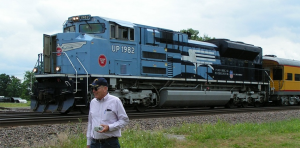 On Monday June 3rd, 2013, four of us, Wally Watts, Thomas Bryan, Matt Gentry and I met up with Gary Ostlund in Gorham IL. To watch trains and talk trains (Army, cars, trucks etc.) for the day. I had planned this around Gary’s regular trip to the VA Clinic in Marion IL. Gary drives his Motor Home to Gorham with his VW in tow and spends a few days track side at Gorham. Also in Gorham is Chuck (Black Pete), a lifelong resident of the sleepy little town. Chuck (whose last name escapes me now) is a twice retired store house of information. While watching trains (or empty track for seven hours as it was) we learned of a track maintenance curfew for the day. BUT…we were rewarded with a Union Pacific Passenger train!!! A Safety Special to promote grade crossing awareness in Illinois and Missouri. The south bound train had the UP CNW Heritage unit in the lead, three passenger cars and the MoPac Heritage unit trailing. The train stopped in Gorham, the crew changed units and the train departed north bound. There was a lot of photo’s, ogling and waves to/from passengers as we took in the scene. It was a really good day with friends and trains regardless of the lack of regular trains. Perhaps we can make this a Chapter Function…anyone?
On Monday June 3rd, 2013, four of us, Wally Watts, Thomas Bryan, Matt Gentry and I met up with Gary Ostlund in Gorham IL. To watch trains and talk trains (Army, cars, trucks etc.) for the day. I had planned this around Gary’s regular trip to the VA Clinic in Marion IL. Gary drives his Motor Home to Gorham with his VW in tow and spends a few days track side at Gorham. Also in Gorham is Chuck (Black Pete), a lifelong resident of the sleepy little town. Chuck (whose last name escapes me now) is a twice retired store house of information. While watching trains (or empty track for seven hours as it was) we learned of a track maintenance curfew for the day. BUT…we were rewarded with a Union Pacific Passenger train!!! A Safety Special to promote grade crossing awareness in Illinois and Missouri. The south bound train had the UP CNW Heritage unit in the lead, three passenger cars and the MoPac Heritage unit trailing. The train stopped in Gorham, the crew changed units and the train departed north bound. There was a lot of photo’s, ogling and waves to/from passengers as we took in the scene. It was a really good day with friends and trains regardless of the lack of regular trains. Perhaps we can make this a Chapter Function…anyone?
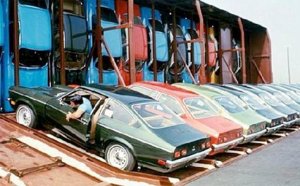 Remember the Chevy Vega? This is how they were shipped. Until the early 1960s, automobiles moved by rail were carried in boxcars. These were 50 feet long with double-wide doors. Inside was room for four full-sized sedans on a two-tier rack – two raised up off the floor on a steel rack and two others tucked in underneath them. This protected the cars during transport but wasnt very efficient, as the weight of four vehicles was far less than the maximum weight a boxcar that size could carry. When 85-foot and 89-foot flatcars came into service, it was possible to pack a total of fifteen automobiles in one car on tri-level auto racks. But it still didn’t approach the maximum allowable weight for each flatcar.
Remember the Chevy Vega? This is how they were shipped. Until the early 1960s, automobiles moved by rail were carried in boxcars. These were 50 feet long with double-wide doors. Inside was room for four full-sized sedans on a two-tier rack – two raised up off the floor on a steel rack and two others tucked in underneath them. This protected the cars during transport but wasnt very efficient, as the weight of four vehicles was far less than the maximum weight a boxcar that size could carry. When 85-foot and 89-foot flatcars came into service, it was possible to pack a total of fifteen automobiles in one car on tri-level auto racks. But it still didn’t approach the maximum allowable weight for each flatcar.
When Chevrolet started designing Vega during the late 1960s, one of the main objectives was to keep the cost of the car down around $2,000 in circa-1970 dollars. At the time, the freight charge for moving a loaded railroad car from the Lordstown, OH assembly plant to the Pacific coast – the longest distance cars produced at Lordstown would need to travel – was around $4,800. Since the Vega was a subcompact, it was possible to squeeze three more cars on a railroad car for a total of eighteen, instead of the usual fifteen. But that still worked out to around $300 per car a substantial surcharge for a $2000 car. If only Chevrolet could get more Vegas on a railroad car, the cost per unit of hauling them would go down.
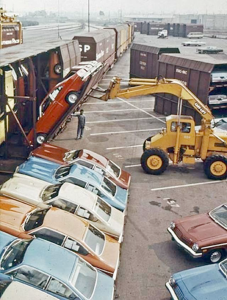 The engineers at GM and Southern Pacific Railroad came up with a clever solution. Instead of loading the cars horizontally, the Vegas were to be placed vertically on a specially designed auto-rack called the Vert-A-Pac. Within the same volume of an 89-foot flatcar, the Vert-A-Pac system could hold as many as 30 automobiles instead of 18.
The engineers at GM and Southern Pacific Railroad came up with a clever solution. Instead of loading the cars horizontally, the Vegas were to be placed vertically on a specially designed auto-rack called the Vert-A-Pac. Within the same volume of an 89-foot flatcar, the Vert-A-Pac system could hold as many as 30 automobiles instead of 18.
Chevrolet’s goal was to deliver Vegas topped with fluids and ready to drive to the dealership. In order to be able to travel nose-down without leaking fluids all over the railroad, Vega engineers had to design a special engine oil baffle to prevent oil from entering the No. 1 cylinder. Batteries had filler caps located high up on the rear edge of the case to prevent acid spilling, the carburetor float bowl had a special tube that drained gasoline into the vapor canister during shipment, and the windshield washer bottle stood at a 45 degree angle. Plastic spacers were wedged in beside the power train to prevent damage to engine and transmission mounts. The wedges were removed when cars were unloaded.
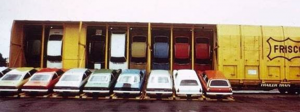 The Vega was hugely popular when it was introduced in 1970, however it quickly earned a reputation for unreliability, rust and terrible engine durability. When the Vega was discontinued in 1977, the Vert-A-Pac cars had to be retired as they were too specialized to be used with anything else. The Vert-A-Pac racks were scrapped, and the underlying flatcars went on to other uses.
The Vega was hugely popular when it was introduced in 1970, however it quickly earned a reputation for unreliability, rust and terrible engine durability. When the Vega was discontinued in 1977, the Vert-A-Pac cars had to be retired as they were too specialized to be used with anything else. The Vert-A-Pac racks were scrapped, and the underlying flatcars went on to other uses.
| Title | BNSF’s Arizona Divide |
| Producer | Railway Productions |
| Format | Wide Screen |
| Playing Time | 1 hr 10 min |
| Purchased From | Trainvideodepot.com |
| Date Purchased | 5/30/2013 |
| Price Paid | $23.95 |
This video takes us east from Kingman, AZ, to Flagstaff, AZ, on a portion of what was once the Santa Fe’s main line across Arizona. We are on the Seligman Sub which stretches from Needles, CA, to Winslow, AZ. The area covered in this video is also known as the “Arizona Divide.”
The video quality is excellent and it is presented in wide screen format. This combination of great image quality and wide screen format makes the desert scenes come alive. This DVD is very near 7idea quality and that says a lot. A shortcoming must also be pointed out, however. There needs to be a more detailed map than the one presented at the start of the video and it should be referred to as we progress along the sub. It is impossible to visualize where we are as the scenes unfold.
The first geographic feature we are shown is Kingman Canyon where the double tracks are at different elevations; one set of tracks is located along the bottom of the canyon and one set of tracks is located part of the way up the canyon wall. We see two trains running in opposite directions in the canyon, one on the lower track and one on the upper track. We see another train meet a little further east in Crozier Canyon but the tracks there are side by side and at the same level.
As we make our eastward progress we gain elevation and eventually leave the desert behind us in favor of pine forests. When we reach Williams, we are at 6700 feet in elevation, a gain of in elevation of 3200 feet above our starting point at Kingman. The narrator informs us that this is the only alpine region along the entire Santa Fe main line from Chicago to LA and we continue our eastward journey until we reach Flagstaff.
This one gets a B. It seemed that the further into it I got, the less impressed I was. It was worth the price but could have been better.
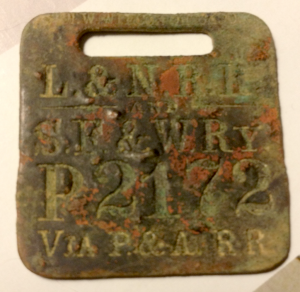 Take a look at this old RR luggage tag. L&N RR and SF&W Ry P2172 via P&A RR. After some Googling, I have L&N RR and South Florida and Western (absorbed by L&N) then the ID number, then via Pensacola & Atlantic RR. Does anyone have more knowledge of these pieces? Best I can tell it is brass. Some were pewter. My neighbor found it in 8 inches of soil just off the old track at Browning Springs Middle School, Madisonville, Ky. Lucky me! – Bill Thomas
Take a look at this old RR luggage tag. L&N RR and SF&W Ry P2172 via P&A RR. After some Googling, I have L&N RR and South Florida and Western (absorbed by L&N) then the ID number, then via Pensacola & Atlantic RR. Does anyone have more knowledge of these pieces? Best I can tell it is brass. Some were pewter. My neighbor found it in 8 inches of soil just off the old track at Browning Springs Middle School, Madisonville, Ky. Lucky me! – Bill Thomas
| Title | Arizona’s Shortline Railroads |
| Producer | Pentrex |
| Format | DVD full screen |
| Playing Time | 1 hr 40 min |
| Purchased From | Trainvideodepot.com |
| Date Purchased | 4/26/2013 |
| Price Paid | $24.95 |
This video shows short line railroad operations in Arizona, with the action taking place in the early 1990s. Several different shortlines are visited and we begin with the Copper Basin Railway which runs 54 miles from Magma Junction, where it interchanges with the old SP line, to Hayden and serves the huge open pit Ray copper mine. This territory is southeast of Phoenix.
We are treated to some panoramic views of the Arizona desert and the enormous open pit Ray mine as we watch the railroad action. We see some switching action involving rare locomotive types. Two of the locomotives we see in action are four-axle GP-39s of which only 23 were ever built. We then see three six-axle SD-39’s of which only 54 were ever built. The GP-39s bring the ore cars up from the mine to Ray Junction and then power is switched to the SD-39s for the trip to the smelter in Hayden. While still on the Copper Basin Railway we are shown some beautiful desert flowers, the iconic saguaro cactus that we all associate with the Arizona desert, an up close and personal look at a four and a half foot long diamondback rattlesnake, and yet another symbol of the Arizona desert, a road runner.
Next up is the San Manuel Arizona Railroad which connects with the Copper Basin Railway at Hayden and runs south for 30 miles to San Manuel. It is owned by the Magma Copper Company and serves their mine at Hayden. We see two GP 38-2’s in action on this railroad. A little later we see a pair of Alco RS 3’s belch their signature billows of black smoke as they begin to move. We see the loading operation at the Magma copper mine, which is both an open pit and an underground mine. Large buckets of ore are elevated from the mine by a huge hoist and the ore is dumped into a silo for loading onto the ore cars.
The Magma Arizona is owned by the same copper company that owns the San Manuel Arizona Railroad. The Magma has on its roster three Baldwin locomotives, an S 8, an S 12, and a six axle DRS 66-1500 that had not been used in years when this video was shot. This railroad operates on 28 miles of track from Magma Junction, where it interchanged with the SP, to Superior.
Next up is the Arizona Eastern which runs 134 miles NW from its connection with the SP at Bowie, AZ, to Miami, AZ, where is serves a smelter owned by Cypress Corporation. We watch a train pulled by three GP 20s run down one of the main streets of Globe, AZ.
We visit the Arizona & California next, which is actually a regional railroad rather than a short line, and then we see the final railroad, the Apache. The Apache rosters all Alco locomotives.
I give this video a good solid “B.” It was worth the purchase price but it would have been so much more impressive if it had been shot in wide screen.
